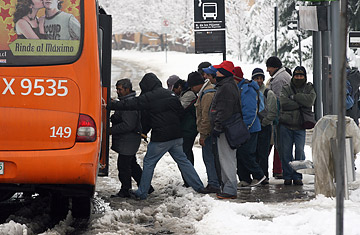
Commuters get in a bus in Santiago de Chile.
Amid the apartment blocks and flyovers of the Chilean capital, Monica Eyzaguirre joins the snaking line of people at a bus stop, unfolds her newspaper and prepares for a long, long wait. "I hate Transantiago with every bone in my body," she says of the city's widely despised new transit system, watching a bus heaving with passengers trundle towards her down a congested road. "I used to take one bus to work and now I have to take three. It's made the lives of millions of people more difficult and more miserable."
Eyzaguirre's complaint is common among Santiago residents these days — ever since the government launched the new transit system in February, commuters have found their daily journeys to work disrupted, their metro trains overcrowded and their roads clogged with traffic.
The government had planned to modify the system but, nearly a year on, it has only succeeded in botching the job. One transport minister has been sacked and another is picking up the pieces, as the transit system is losing over $1 million a day. Transantiago — possibly the most hated word in the Chilean lexicon — is a classic case of a good idea wrecked in the implementation.
There was no question the city's old transport system needed changing. It was deregulated, chaotic, dirty and sometimes dangerous. Drivers were forced to compete for fares, overtaking one another at breakneck speeds to reach passengers first. Buses were old and belched black fumes. So, the government decided to replace the old bus routes with new ones linked to the metro network in a system that has eliminated cash and works entirely by swipe cards. The battered old yellow buses have been replaced by smart new high-tech fleet.
The problem is that there are simply not enough new buses to meet demand — 8,000 old ones were replaced by around 5,500 of the new ones — which has meant long lines, overcrowding and frayed tempers.
The launch of the new routes was poorly publicized, leaving passengers confused. The government opted for a "big bang" approach: Six million Santiaguinos took their last bus ride home on February 9 in one transport system, and then were expected to find their way to work and school on February 10 in an entirely new one. Wisdom of hindsight suggests incremental changes may have been less traumatic.
Meanwhile, the metro, the jewel in Transantiago's crown, is creaking under the strain of twice as many passengers as before. "We used to be proud of our metro," says student Andres Carrera as he shuffles on to a crowded platform. "Now we just make jokes about it."
The problem is exacerbated by the city's fragmented government structure. Santiago has over 30 mayors, one for each of its districts. With no single executive office in charge of the city as a whole, the job of implementing Transantiago has fallen to the national government. Imagine President George W. Bush getting bogged down in rewiring the New York City mass transit system, and you get the idea.
"Transantiago has got very severe problems," says Juan Carlos Munoz, professor of transport engineering and logistics at Santiago's Pontifical Catholic University. "It's got better since it was launched but only very slowly. The main problems are still unresolved."
Munoz blames Transantiago's woes on a lack of infrastructure (there are very few bus lanes, for example), inadequate information, and the government's steadfast refusal to subsidize the project from the outset. Still, with so much anger on the streets, the government simply cannot afford to hike fares to meet the shortfall, even though the system is losing money. Instead, it keeps asking parliament to approve additional funding. In June, Congress agreed a cash injection of $290 million, but last month refused to approve further funds.
The problems afflicting Transantiago have, meanwhile, created a vicious circle. Fed up with poor public transport, people use private cars to get to work. That blocks roads, which delays buses, which makes the transport system worse, and prompts even more commuters to travel by car. Car sales have jumped in recent months, while bicycle shops and scooter outlets are enjoying a roaring trade.
One group of commuters has even launched a class action suit against the government, blaming it for worsening their lives. The suit is unlikely to succeed, but it's a signal of popular discontent. In fact, Transantiago has pounded the approval ratings of President Michelle Bachelet. According to pollsters Adimark GFK, the Socialist Party president's rating slumped to 38.2% in November from over 60% in April 2006. Unsurprisingly, that fall has been sharpest in the capital.
Bachelet has not hesitated to eat humble pie over Transantiago. She has apologized publicly and, at a recent breakfast with foreign correspondents, said the system's failures caused her "deep pain." The debacle is a particular embarrassment to Chile, which prides itself on being an oasis of order in an often chaotic continent. A parliamentary commission is investigating what went wrong with Transantiago, and its report is not expected to make happy reading. But Santiaguinos will have plenty of time to read it, while waiting on line for buses.
